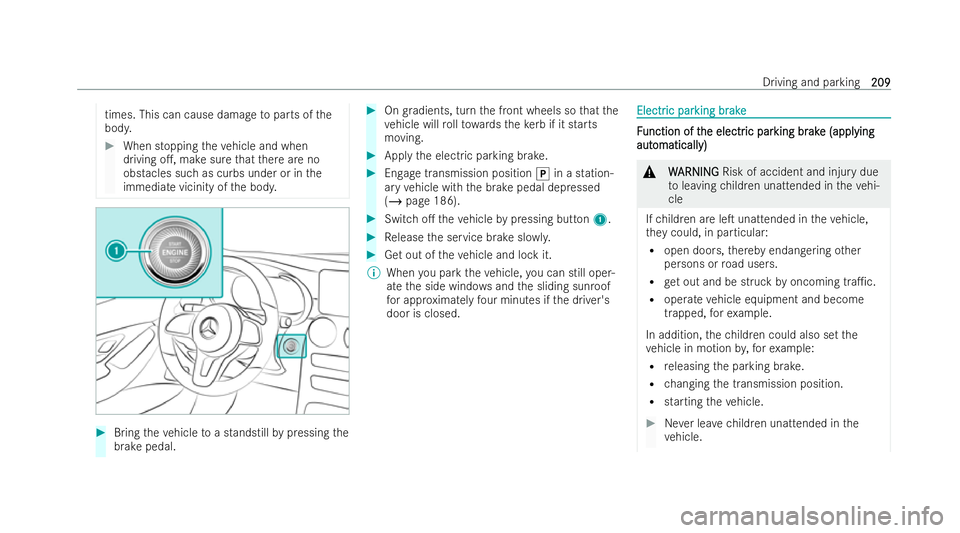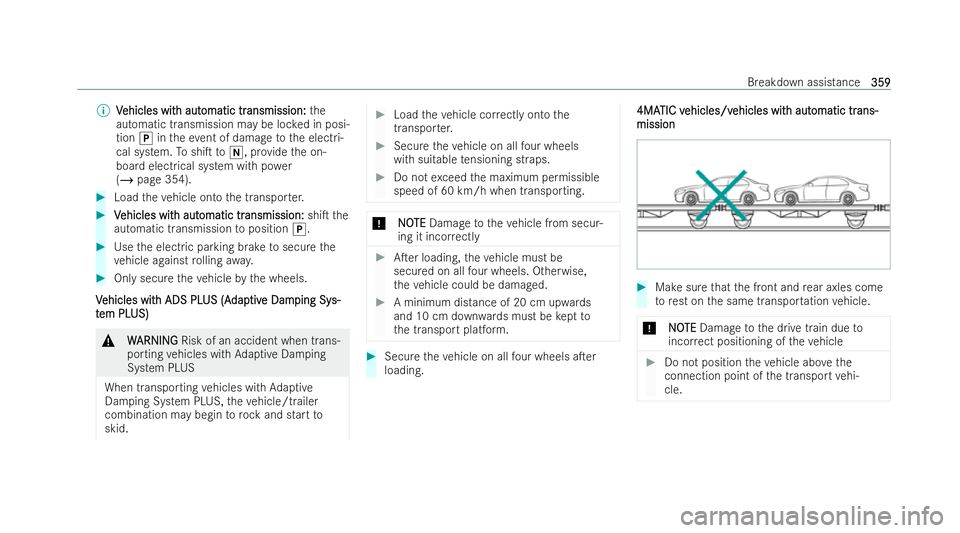Page 192 of 525

R
Speed
R Operating status of the engine
R Tra�1c situation F
F
unction of t
unction of t he 4MA
he 4MATIC
TIC
4MATIC ensu resth at all four wheels are driven.
To ge ther with ESP ®
and 4ETS, 4MATIC impr oves
th e traction of your vehicle whene ver a driven
wheel spins due toinsu�1cient traction.
If yo ufa ilto adapt your driving style, 4MATIC can
neither reduce therisk of an accident nor override
th e la wsof ph ysics. 4MATIC cannot take account
of road, weather and tra�1c conditions. 4MATIC is
only an aid. You are responsible especially for
maintaining a safe distance from theve hicle in
front, forve hicle speed, for braking in good time
and for st aying in lane.
% In wintry road conditions, the maximum e�.ect
of 4MATIC can be achie ved only if you use
winter tyres (M+S tyres), with snow chains if
necessar y. R
R
efuelling
efuelling R
R
efuelling t
efuelling t he v
he vehicle
ehicle &
W
WARNING
ARNING Risk of �/re or explosion from
fuel
Fu els are highly �0ammable. #
Fire , naked �0ames, smoking and creating
spar ksmust be avoided. #
Before refuelling, switch o�. theve hicle
and, if �/tted, the stationary heater and
ke ep switched o�. during �/lling. &
W
WARNING
ARNING Risk of injury from fuels
Fu els are poisonous and hazardous toyour
health. #
Do not swallow fuel or let it come into
contact with skin, eyes or clo thing. #
Do not inhale fuel vapour. #
Keep children away from fuel. #
Keep doors and windo wsclosed during
th ere fuelling process. If
yo u or other people come into contact with
fuel, obser vethefo llowing: #
Immediate lyrinse fuel o�. your skin with
soap and water. #
If fuel comes into contact with your eyes,
immediately rinse them thoroughly with
clean water. Seek medical at tention
immedia tely. #
Ifyo u swallow fuel, seek medical atten-
tion immediatel y.Do not induce vomit-
ing. #
Change immediately out of clo thing that
has come into contact with fuel. &
W WARNING
ARNING Risk of �/re and explosion due
to electrostatic charge
Electrostatic charge can ignite fuel vapour. #
Before you open the fuel �/ller cap or
ta ke hold of the pump nozzle, touch the
me tallic vehicle body. Driving and parking
189
189
Page 212 of 525

times. This can cause damage
toparts of the
body. #
When stopping theve hicle and when
driving o�., make sure that there are no
obstacles such as curbs under or in the
immediate vicinity of the body. #
Bring theve hicle toa standstill bypressing the
brake pedal. #
Ongradients, turn the front wheels so that the
ve hicle will rollto wa rdsth eke rb if it starts
moving. #
Apply the electric parking brake. #
Engage transmission position jin a station-
ary vehicle with the brake pedal depressed
(/ page 186). #
Switch o�. theve hicle bypressing button 1. #
Release the service brake slo wly. #
Get out of theve hicle and lock it.
% When you park theve hicle, you can still oper-
ate the side windo wsand the sliding sunroof
fo r appr oximately four minutes if the driver's
door is closed. Electr
Electr
ic par
ic parking br
king br ake
ake F
F
unction of t
unction of t he electr
he electric par
ic parking br
king br ak
ake (appl
e (appl ying
ying
aut
aut omaticall
omaticall y)
y) &
W
WARNING
ARNING Risk of accident and injury due
to leaving children unattended in theve hi-
cle
If ch ildren are le�T unattended in theve hicle,
th ey could, in particular:
R open doors, thereby endangering other
persons or road users.
R get out and be struck byoncoming tra�1c.
R operate vehicle equipment and become
trapped, forex ample.
In addition, thech ildren could also set the
ve hicle in motion by,fo rex ample:
R releasing the parking brake.
R changing the transmission position.
R starting theve hicle. #
Never lea vechildren unattended in the
ve hicle. Driving and parking
209
209
Page 362 of 525

%
V
V ehicles wit
ehicles wit h aut
h automatic tr
omatic tr ansmission:
ansmission: the
automatic transmission may be loc ked in posi-
tion jintheev ent of damage tothe electri-
cal system. Toshi�T toi , pr ovide the on-
board electrical system with po wer
( / page 354). #
Load theve hicle onto the transpor ter. #
V
Vehicles wit
ehicles wit h aut
h automatic tr
omatic tr ansmission:
ansmission: shi�Tthe
automatic transmission toposition j. #
Use the electric parking brake tosecure the
ve hicle against rolling away. #
Only secure theve hicle bythe wheels.
V
V ehicles wit
ehicles wit h ADS PL
h ADS PLUS (A
US (Adap
daptiv
tive Dam
e Dam ping Sy
ping Sy s-
s-
t
t em PL
em PL US)
US) &
W
WARNING
ARNING Risk of an accident when trans-
porting vehicles with Adaptive Damping
System PLUS
When transpo rting vehicles with Adaptive
Damping System PLUS, theve hicle/trailer
combination may begin torock and start to
skid. #
Load theve hicle cor rectly onto the
transpor ter. #
Secure theve hicle on all four wheels
with suitable tensioning straps. #
Do not exceed the maximum permissible
speed of 60 km/h when transporting. *
N
NOOTE
TE Damage totheve hicle from secur-
ing it inco rrectly #
A�Ter loading, theve hicle must be
secured on all four wheels. Otherwise,
th eve hicle could be damaged. #
A minimum dis tance of 20 cm upwards
and 10 cm down wards must be kept to
th e transport platform. #
Secure theve hicle on all four wheels a�Ter
loading. 4MA
4MA
TIC v
TIC v ehicles/v
ehicles/v ehicles wit
ehicles wit h aut
h automatic tr
omatic tr ans-
ans-
mission
mission #
Make sure that the front and rear axles come
to rest on the same transpor tation vehicle.
* N
NOOTE
TE Damage tothe drive train due to
incor rect positioning of theve hicle #
Do not position theve hicle abo vethe
connection point of the transport vehi-
cle. Breakdown assis
tance
359
359